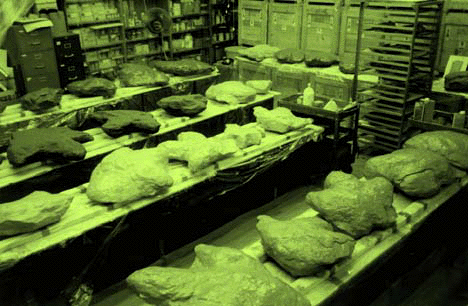|
|
  Copies cast from
artificial moulds taken from original natural casts of dinosaur
tracks from the roofs of coal mines in central Utah, from the collection of the College of Eastern Utah Prehistoric Museum, in the city of Price, Carbon County, Utah; produced in polymerized, glass-fibre-reinforced gypsum.
Copies cast from
artificial moulds taken from original natural casts of dinosaur
tracks from the roofs of coal mines in central Utah, from the collection of the College of Eastern Utah Prehistoric Museum, in the city of Price, Carbon County, Utah; produced in polymerized, glass-fibre-reinforced gypsum.
| In the field, it is often easier to make artificial casts or moulds then to try collecting the original tracks. Footprints in the form of natural moulds provide artificial casts, and natural casts are the basis for artificial moulds. Such artificial casts and moulds are valuable for several reasons. First, they are permanent three-dimensional records of footprints that occur at remote or inaccessible sites or that otherwise run some risk of being destroyed or lost. Secondly, an artificial cast may reveal details of footprint structure that are not apparent in a natural mould; artificial moulds may be equally enlightening in the study of natural casts. Thirdly, the artificial casts or moulds are easily duplicated in the laboratory and may also be used to manufacture replicas of the original footprints. A cast of an artificial mould will replicate the morphology of the original natural cast; and, likewise, a mould of an artificial cast will replicate the original natural mould. Such secondary casts and moulds will, in effect be exact duplicates of the original footprints, be they casts or moulds. Such replicas may be produced in plaster or latex, and may also be manufactured in various combinations of plastic, resin and glass fibre, all of which share the advantages of light weight and durability. Such replicas can be astonishingly realistic, especially when tinted to match the originals, and are very satisfactory as museum exhibits. They also have another advantage: they permit leisurely study of dinosaur tracks discovered in remote or hazardous locations. |